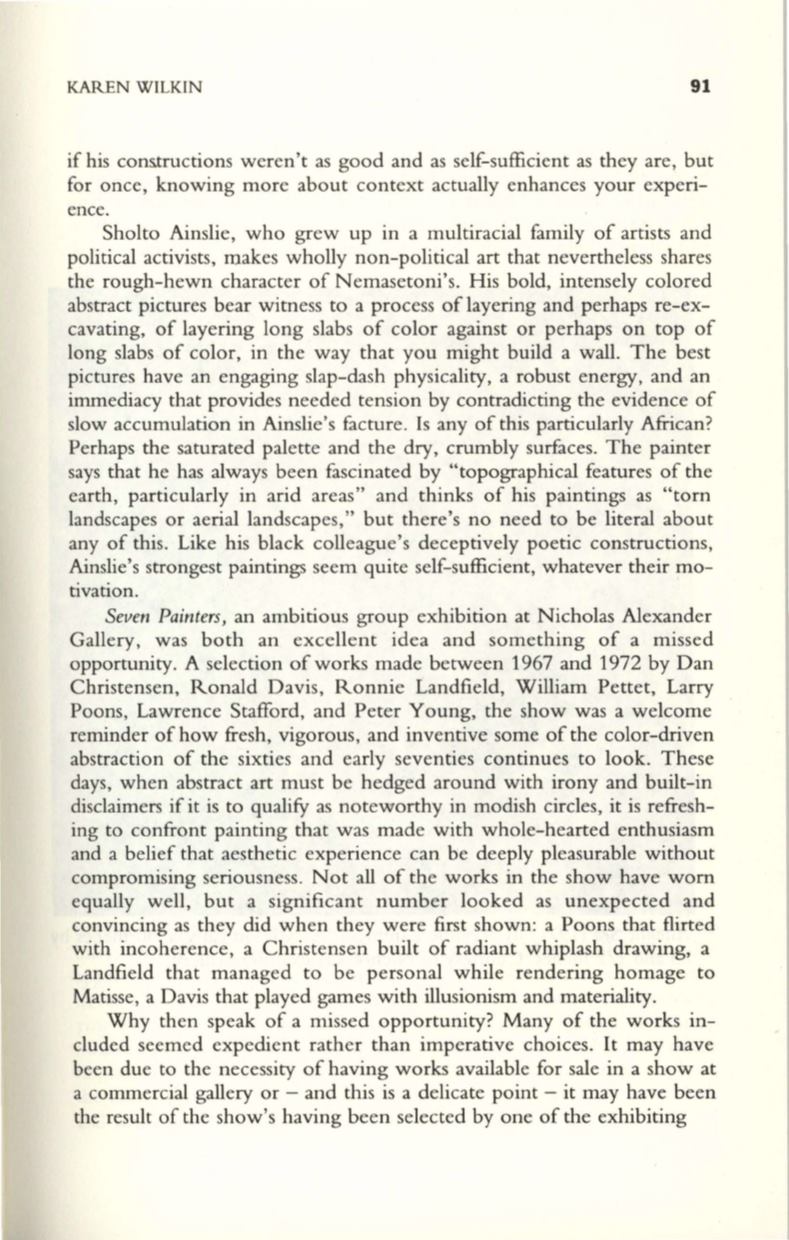
KAREN WILKIN
91
if his cons.tructions weren't as good and as self-sufficient as they are, but
for once, knowing more about context actually enhances your experi–
ence.
Sholto Ainslie , who grew up in a multiracial family of artists and
political activists, makes wholly non-political art that nevertheless shares
the rough-hewn character of Nemasetoni's. His bold, intensely colored
abstract pictures bear witness to a process of layering and perhaps re-ex–
cavating, of layering long slabs of color against or perhaps on top of
long slabs of color, in the way that you might build a wall. The best
pictures have an engaging slap-dash physicality, a robust energy, and an
immediacy that provides needed tension by contradicting the evidence of
slow accumulation in Ainslie's facture. Is any of this particularly African?
Perhaps the saturated palette and the dry, crumbly surfaces. The painter
says that he has always been fascinated by "topographical features of the
earth, particularly in arid areas" and thinks of his paintings as "torn
landscapes or aerial landscapes," but there's no need to be literal about
any of this. Like his black colleague's deceptively poetic constructions,
Ainslie's strongest paintings seem quite self-sufficient, whatever their mo–
tivation.
Seven Painters,
an ambitious group exhibition at Nicholas Alexander
Gallery, was both an excellent idea and something of a missed
opportunity. A selection of works made between 1967 and 1972 by Dan
Christensen, Ronald Davis, Ronnie Landfield, William Pettet, Larry
Poons, Lawrence Stafford, and Peter Young, the show was a welcome
reminder of how fresh, vigorous, and inventive some of the color-driven
abstraction of the sixties and early seventies continues to look. These
days, when abstract art must be hedged around with irony and built-in
disclaimers if it is to qualifY as noteworthy in modish circles, it is refresh–
ing to confront painting that was made with whole-hearted enthusiasm
and a belief that aesthetic experience can be deeply pleasurable without
compromising seriousness. Not all of the works in the show have worn
equally well, but a significant number looked as unexpected and
convincing as they did when they were first shown: a Poons that flirted
with incoherence, a Christensen built of radiant whiplash drawing, a
Landfield that managed to be personal while rendering homage to
Matisse, a Davis that played games with illusionism and materiality.
Why then speak of a missed opportunity? Many of the works in–
cluded seemed expedient rather than imperative choices.
It
may have
been due to the necessity of having works available for sale in a show at
a commercial gallery or - and this is a delicate point - it may have been
the result of the show's having been selected by one of the exhibiting


